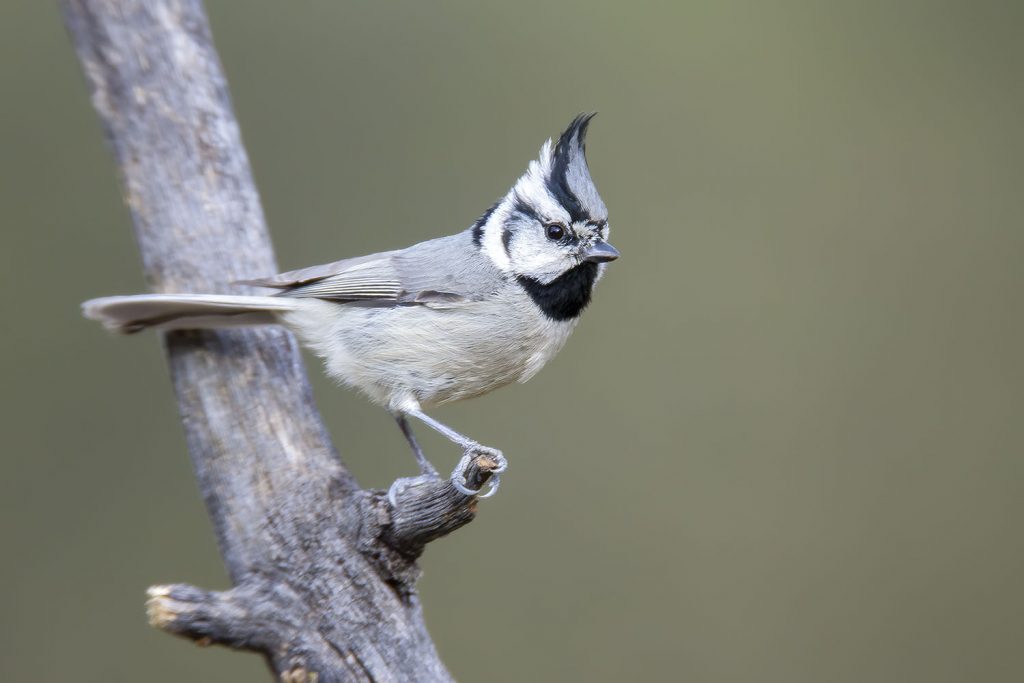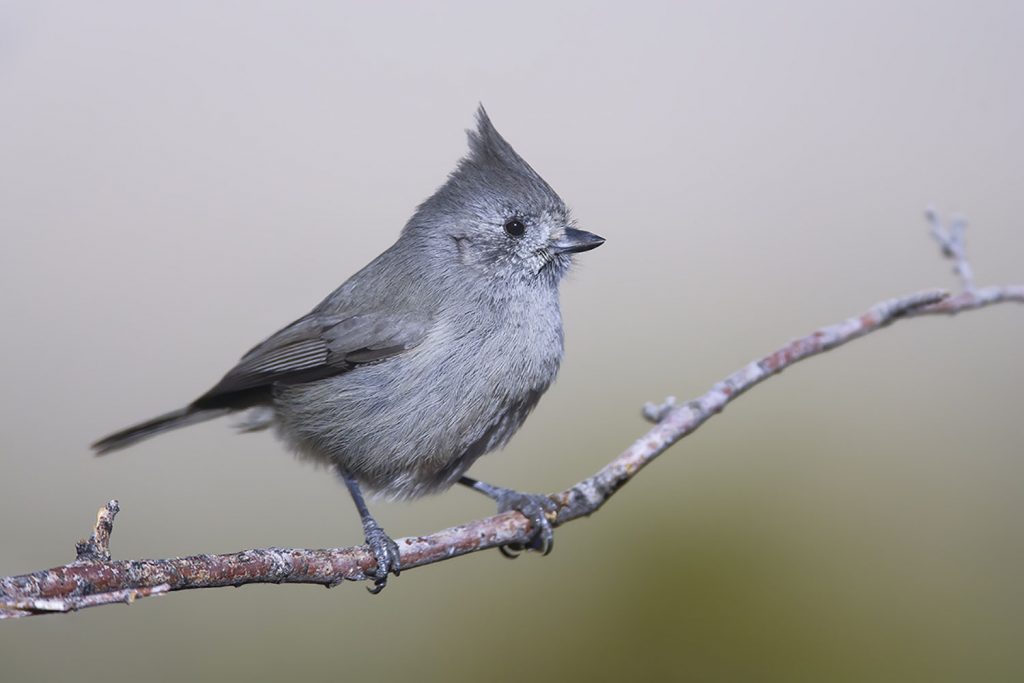By Kenn Kaufman, Brian E. Small, BirdWatching Magazine

Members of the titmouse family are among the most familiar and popular backyard birds across North America. The best known undoubtedly are the chickadees, a handful of dark-capped sprites that flock to feeders over most of the U.S. and Canada. The crested titmice of the genus Baeolophus are not quite so numerous or widespread, but they are welcome backyard visitors over much of the lower 48 states and southeastern Canada.
The five species form a distinct group within the family. All have short crests they can raise or lower at will. One species, Bridled Titmouse, is about the size of a chickadee, but the other four all average larger. Bridled often forms flocks of more than half a dozen in the non- breeding season, as chickadees do, but the other four crested titmice are more often seen in groups of only two or three. All of the birds nest in cavities, but chickadees in general seem more likely to excavate or enlarge holes for use, while titmice are more likely to use unmodified holes.
Tufted Titmouse is the member of this group that’s familiar to the largest number of people. Most abundant in the southeastern states, it extends north to the Great Lakes and New England and locally into southeastern Canada; it’s a regular visitor to millions of bird feeders. With its perky facial expression and cheery peeto-peeto-peeto whistles, it’s a perennial favorite for many backyard birders.
A related bird, Black-crested Titmouse, is common over much of Texas and northeastern Mexico, extending into southwestern Oklahoma. Where its range meets that of Tufted Titmouse, in a narrow zone through east-central Texas, they often hybridize. For that reason, the birds were “lumped” into one species in 1976. After further studies, the two were split again in 2002 because the interbreeding between them is limited, and there are genetic and vocal differences. But for observers in the field, the similarities between the two species are obvious.
An even closer species pair involves Oak Titmouse and Juniper Titmouse of the West. Historically, the two always had been treated as just one species, under the name Plain Titmouse. They were not recognized as separate species until 1997. Oak Titmouse is practically a California specialty, extending north into Oregon and south into Baja. Common in oak woods, it’s also a regular visitor to backyards with good tree cover. Juniper Titmouse is widespread in the interior of the West, but it’s generally uncommon, living out in sparse woodlands of juniper and pinyon pine.
Finally, the most distinctive member of the group is Bridled Titmouse. Mainly a bird of Mexico, it’s locally common in Arizona and New Mexico, and it regularly visits feeders in wooded canyons of the foothills. Smaller in overall size and forming larger flocks than the other crested titmice, it seems in some ways to be intermediate between those birds and the chickadees.
What to look for
Size and shape. Small, round-bodied songbirds, with short crests and short, stout bills.
Behavior. Foraging actively from twigs to major limbs to trunks of trees, and sometimes on the ground.
Face and crest pattern. Varies from ornate on Bridled Titmouse to very plain on Oak and Juniper Titmice.
Distribution. Because there is very little overlap among the five species, in most cases they can be identified by range.
Voice. Where Oak and Juniper Titmice meet in northeast California, differences in song are the best way to identify them.

In overall appearance and behavior, the Black-crested Titmouse is very similar to Tufted Titmouse, replacing it across much of Texas and a bit of southwest Oklahoma, and south into Mexico. The adult’s black crest (often raised high) and white forehead are clearly different from the gray crest and black forehead of the Tufted. On juvenile Black-crested Titmice, the crest is dark gray at first. In the narrow zone where the two species meet, they interbreed fairly often; adult hybrids usually have dark gray crests, but the forehead color is often an odd shade of brown. The voices of the two species are quite similar, but the song of the Black-crested averages a little faster and higher-pitched.

In its limited range north of the border in Arizona and New Mexico, the Bridled Titmouse is very common in oak woodlands or mixtures of oaks and pines at middle elevations, extending to lowland rivers in some places. Smaller, more sharply marked, and more sociable than the other crested titmice in North America, it is easily distinguished from them, although at a glance it might be mistaken for a chickadee or for some species of warbler. Travelers will note that it looks similar to the Crested Tit of Europe and western Asia. Although the two are not close relatives, they may share some evolutionary history, as noted in the sidebar on the next page.

Drab but personable, this lively titmouse visits backyards well-supplied with oaks or other trees over much of California and a bit of southwestern Oregon. Until 1997, Oak and Juniper Titmice were combined in one species under the name Plain Titmouse — an apt description. Aside from their short crests, these birds seem utterly devoid of field marks. Visually, the two are almost identical. Oak Titmouse averages browner, Juniper Titmouse paler and grayer, but even slight shifts in lighting can make the difference moot. Although ranges of the two species approach each other closely in eastern California, overlap between them has been studied mainly in Modoc County in the state’s northeastern corner, where they are best identified by voice.

Titmouse history
Scientists have examined practically everything about members of the titmouse family, including their evolutionary history. One study, published in 2005, offered a possible timeline for how North America’s species evolved.
It said the ancestors of the crested titmice (genus Baeolophus) may have entered North America from Asia about 4 million years ago (half a million years before the ancestors of the chickadees). The original colonizer might have been something like Europe’s Crested Tit or our Bridled Titmouse. Based on genetics, the first ancestor of the current four species without strong face patterns probably split off from the Bridled Titmouse line relatively early in their occupation of this continent. Later, in the mid- to late Pliocene (or a little more than 2.6 million years ago), the Tufted/Black-crested Titmouse complex diverged from the western Oak/Juniper Titmouse complex.
The further divisions in these groups apparently were more recent. Tufted and Black-crested Titmice may have separated from each other only about 250,000 years ago. And Juniper Titmouse is thought to have diverged from Oak Titmouse around the end of the Pleistocene, or only about 12,000 years ago.
Notably, the results, based on genetics, match what we might expect from observation: Bridled is most distinctive, Tufted and Black-crested seem more closely related, while the distinctions between Oak and Juniper Titmice are very slight.

Kenn Kaufman is an expert birder and naturalist, a talented artist and photographer, a world traveler, and the author of many books about birds and other wildlife. His column “ID Tips” appears in every issue of BirdWatching. Kenn is also a field editor for Audubon Magazine and a contributor to Birds and Blooms. His work first appeared in Birder’s World (now BirdWatching) in April 1988. Visit his website, Kaufman Field Guides

Brian Small is a Los Angeles-based bird and nature photographer whose photos appear in the “ID Tips” column in every issue of BirdWatching. His work has been published in Time, The New York Times, Audubon, Nature Conservancy, National Wildlife, Wildlife Conservation, and many other publications. His photos also illustrate many field guides, including Kenn Kaufman’s Birds of North America, a series of state bird identification guides published with the American Birding Association, and his own Eastern and Western photographic field guides to the birds of North America published in 2009 with author Paul Sterry and Princeton University Press.